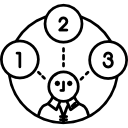Computational thinking, problem-solving and programming: Difference between revisions
| Line 43: | Line 43: | ||
=== Programming Design === | === Programming Design === | ||
* [[Linear arrays]] | |||
* [[Collections]] | |||
* [[Pseudocode]] | |||
* [[Algorithms]] | |||
* [[Applied algorithmic thinking]] | |||
=== Introduction to Programming === | === Introduction to Programming === | ||
Revision as of 15:23, 12 April 2016
This is one of the most important ideas you can take with you:
Decompose a problem into smaller parts, model a problem with flowcharts. Learn to think sequentially

Computational Thinking (CT) is a process that generalizes a solution to open-ended problems. Open-ended problems encourage full, meaningful answers based on multiple variables, which require using decomposition, data representation, generalization, modeling, and algorithms found in Computational Thinking. Computational Thinking requires the decomposition of the entire decision making process, the variables involved, and all possible solutions, ensuring that the right decision is made based on the corresponding parameters and limitations of the problem. The term computational thinking was first used by Seymour Papert in 1980[1] and again in 1996.[2] Computational thinking can be used to algorithmically solve complicated problems of scale, and is often used to realize large improvements in efficiency[2]
The big ideas in computational thinking[edit]
Thinking procedurally[edit]
Thinking logically[edit]
Thinking ahead[edit]
Thinking concurrently[edit]
Thinking abstractly[edit]
Programming Design[edit]
Introduction to Programming[edit]
- Fundamental operations
- Compound operations
- What is a programming language?
- High level languages
- Low level languages
- Translating high-level code to low-level code
Use of programming languages[edit]
- Variables (See also: data types and primitive data types)
- Constants (See also: data types and primitive data types)
- Objects (See also: data types and primitive data types)
- Operators
- Algorithms
- Collections
- Functions